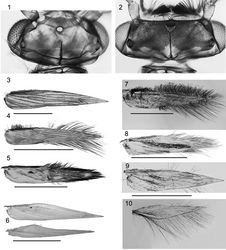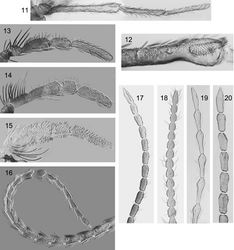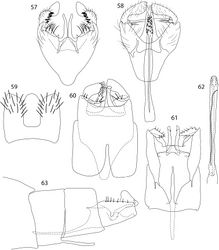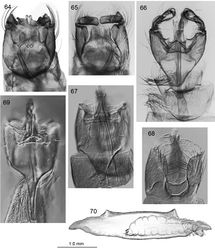Caledonotrichia extensa
| Notice: | This page is derived from the original publication listed below, whose author(s) should always be credited. Further contributors may edit and improve the content of this page and, consequently, need to be credited as well (see page history). Any assessment of factual correctness requires a careful review of the original article as well as of subsequent contributions.
If you are uncertain whether your planned contribution is correct or not, we suggest that you use the associated discussion page instead of editing the page directly. This page should be cited as follows (rationale):
Citation formats to copy and paste
BibTeX: @article{Wells2013ZooKeys287, RIS/ Endnote: TY - JOUR Wikipedia/ Citizendium: <ref name="Wells2013ZooKeys287">{{Citation See also the citation download page at the journal. |
Ordo: Trichoptera
Familia: Hydroptilidae
Genus: Caledonotrichia
Name
Caledonotrichia extensa Kelley – Wikispecies link – Pensoft Profile
- Caledonotrichia extensa Kelley (1989: 195).
Revised diagnosis
As noted by Kelley (1989)[1] Caledonotrichia extensa is distinctive in being larger than any other species; as in males of Caledonotrichia nyurga antennae are extremely long, just exceeding length of body, but in contrast to that species the segments (Fig. 19) tend to be more elongate, inverted urn-shaped, not bead-like, and the longest segments are about 6× as long as wide; maxillary palps (Figs 11–12) with segments 1 and 2 round, segments 4 and 5 length about 8× width, segment 3 length about 1.5× length of each of terminal segments, swollen apically and bearing area of sensilla apico-dorsally (Fig. 12); male genitalia are clearly visible under a dissecting microscope, with abdominal sternite IX deeply concave distally, ventral lobes of gonopods rounded, bearing row of stout dark setae on mesal margin, not narrowly membranous and leaf-like as in Caledonotrichia nyurga, or slender and finger-like as in Caledonotrichia sykorai sp. n.
Additional information, male
Head subquadrate; antennae (Fig. 19) with 25–26 flagellomeres (n=10); scape elongate-rounded, pedicel short, rounded, other flagellomeres elongate-cylindrical to flask-shaped, bearing numerous sensilla coeloconica.
Forewing (Fig. 3) without scales or specialised setae, venation more complete than in other congeners; length: 2.2–3.6 mm (n=10).
Genitalia (Figs 57–58, 66). Abdominal segment IX in ventral view almost triangular, strongly tapered and narrowly rounded anteriorly, a deep concavity on posterior margin of sternite. Tergite X narrow, elongate, straight sided, rounded apically. Gonopods with ventral lobe length 1.5X width, bearing stout setae on mesal margin and apically, dorsal lobe elongate club-shaped, a row of sclerotised short setae subapico-mesally, most distal pair bent sharply, axillary seta long, slender, apically acute. Sclerotised rods of subgenital process straight, slightly sculptured apically. Phallic apparatus straight, elongate, slender, with a dorsal crease along two-thirds length and with associated spine-covered apical membrane.
Case of mature larva (Fig. 70). Cigar-shaped, with a pair of dorsal vents and at each end a bract-like overhang. Cased larvae of Caledonotrichia extensa were associated via pharate adults, and demonstrate that unlike the larvae of Caledonotrichia illiesi that live in fixed dome-shaped cases, larvae of Caledonotrichia extensa are mobile, carrying their cases about. These portable cases are cigar-shaped, tapered at each end and comprise two identical secretion valves, clearly with an upper and lower side. In common with cases of Caledonotrichia illiesi, however, cases of Caledonotrichia extensa have dorsal vents, although in Caledonotrichia extensa these are larger openings, situated near the ends of the dorsal seam of the two valves and opening away from the case.
Material examined
Holotype male: New Caledonia: mountain stream up Boulari River (BPBM).
Additional material examined
New Caledonia: 1 cased larva, Ouarou River, source of Tchamba R., N of Ponerinouen, 25.viii.1965, F. Starmühlner (ROM); prepupae, pupae, middle Tchamba R., below Tchamba, 26.viii.1965, F. Starmühlner (ROM); 8 males, Nerihouen River, St Ives, Reg. Ponérihouen, 27.viii. 1965, F. Starmühlner (ROM); larvae, pupae, St Ives Reg. Ponérihouen, 27.viii. 1965, F. Starmühlner (ROM); larvae, pupae, 1 female, 3 km from mouth of Mou River, Reg. Ponérihouen, 28.viii. 1965, F. Starmühlner (ROM); 1 prepupa, river Col d’Boa, [no date], F. Starmühlner (ROM); 1 male, Yaté turnoff, 24.viii.1973, A.G. McFarlane & R.A. Savill; 1 male, 1 female, 4 km SW Col de Mouirange, 20 m, 10.viii.1979, G.M. Nishida (BPBM); larvae, pupae, Boghen, Oct. 1996, N. Mary (ANIC); 45 males, Rivière du Cap, Pont du Cap, approx 8 km NW Naindai on Bourail-Poya road, 22.xii.1998, A. Wells; 3 males, stream, approx 15 km SW Thio on Boulouparis-Thio road, 28.xii.1998, A. Wells (ANIC); pupae, River Ni, 25 July 2000, N. Mary (ANIC); 1 male, Province Nord, Ponandou Tiôgé River at Kögi, 3.9 km SSW Touho, 20°49.043'S, 165°13.551'E, 25 m, 26.xii.2003, light trap, loc#100, K. A. Johanson (NHRS).
Taxon Treatment
- Wells, A; Johanson, K; Mary-Sasal, N; 2013: The New Caledonian genus Caledonotrichia Sykora (Trichoptera, Insecta) reviewed, with descriptions of 6 new species ZooKeys, 287: 59-89. doi
Other References
- ↑ Kelley R (1989) New species of micro-caddisflies (Trichoptera: Hydroptilidae) from New Caledonia, Vanuatu and Fiji. Proceedings of the Entomological Society of Washington 91 (2): 190-202.
Images
|



